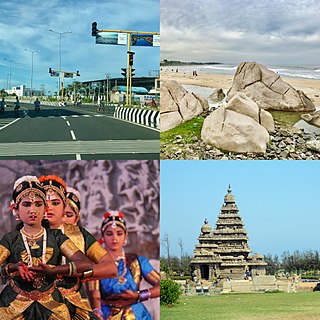
Mamallapuram, also known as Mahabalipuram, is a town in Chengalpattu district in the southeastern Indian state of Tamil Nadu, best known for the UNESCO World Heritage Site of 7th- and 8th-century Hindu Group of Monuments at Mahabalipuram. It is one of the famous tourist sites in India. The ancient name of the place is Thirukadalmallai. It is a part of Chennai Metropolitan Area. It is a satellite town of Chennai.
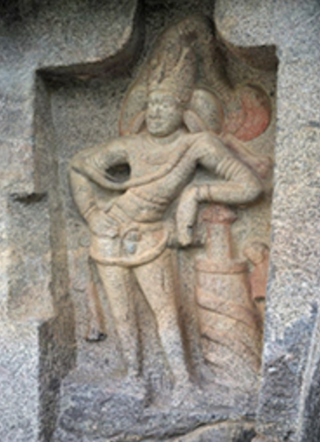
Mahendravarman I was a Pallava emperor who ruled the Southern portion of present-day Andhra region and Northern regions of what forms present-day Tamil Nadu in India in the early 7th century. He was a scholar, painter, architect, musician. He was the son of Simhavishnu, who defeated the Kalabhras and re-established the Pallava kingdom.

There have been at least four lighthouses named Chennai Lighthouse or Madras Lighthouse, which face the Bay of Bengal on the east coast of the Indian Subcontinent in Chennai, India.
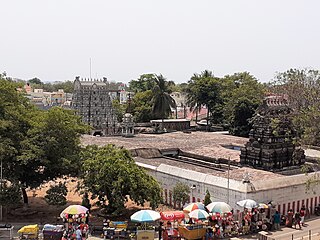
Sthalasayana Perumal Temple is at Mahabalipuram. Constructed in the Dravidian style of architecture, the temple is glorified in the Naalayira Divya Prabandham, the early medieval Tamil canon of the Alvar saints from the 6th–9th centuries CE. It is one of the 108 Divya Desam dedicated to Vishnu, who is worshipped as Sthalasayana Perumal and his consort Lakshmi as Nilamangai Thayar. The temple is believed to have been built by the Pallavas, with later contributions from the Medieval Cholas, Vijayanagara kings, and Madurai Nayaks.
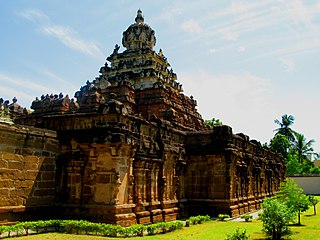
Thiru Parameswara Vinnagaram or Vaikunta Perumal Temple is a temple dedicated to Vishnu, located in Kanchipuram in the South Indian state of Tamil Nadu. Constructed in the Dravidian style of architecture, the temple is glorified in the Nalayira Divya Prabandham, the early medieval Tamil canon of the Alvar saints from the 6th through the 9th centuries CE. It is one among the 108 Divya Desams dedicated to Vishnu, who is worshipped as Vaikuntanathan and his consort Lakshmi as Sri Vaikundavalli. The temple is considered the second oldest extant temple in Kanchipuram after the Kailasanathar temple.
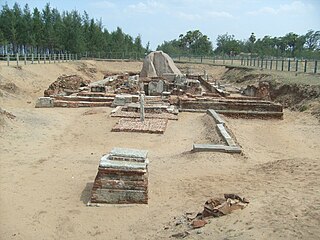
The Murugan Temple at Saluvankuppam, Tamil Nadu, India, is a shrine dedicated to Tamil Hindu deity Murugan. Archaeologists believe that the shrine, unearthed in 2005, consists of two layers: a brick temple constructed during the Sangam period and a granite Pallava temple dating from the 8th century CE and constructed on top of the brick shrine making it the oldest temple in india. The Archaeological Survey of India (ASI) team which conducted the excavation believe that brick temple could be the oldest of its kind to be discovered in Tamil Nadu.

Tamil Nadu is known for its ancient temple architecture. Nearly 33,000 ancient temples, many at least 800 to 2000 years old, are found scattered all over Tamil Nadu. As per Tamil Nadu Hindu Endowments Board, there are 38,615 temples. Most of the largest Hindu Temples reside here. Studded with complex architecture, a variety of sculptures, and rich inscriptions, the temples remain the very essence of the culture and heritage of Tamil land, with historical records dating back to at least 3,000 years.
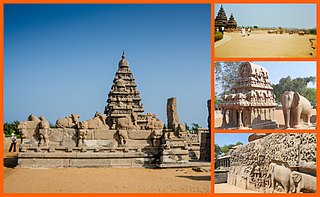
The Group of Monuments at Mahabalipuram is a collection of 7th- and 8th-century CE religious monuments in the coastal resort town of Mahabalipuram, Tamil Nadu, India and is a UNESCO World Heritage Site. It is on the Coromandel Coast of the Bay of Bengal, about 60 kilometres (37 mi) south of Chennai.

The Shore Temple is a complex of temples and shrines that overlooks the shore of the Bay of Bengal. It is located in Mahabalipuram, about 60 kilometres (37 mi) south of Chennai in Tamil Nadu, India.

The Olakkannesvara Temple is in Mahabalipuram town, overlooking the Coromandel Coast of the Bay of Bengal in Kancheepuram District in Tamil Nadu, India. Like the Shore Temple, the Olakkannesvara Temple is a structural temple. Built in the 8th century, it is situated directly above the Mahishasuramardini mandapa on a hillock which provides scenic views of the town. As the area is within a high security zone because of a nuclear power station a few kilometres to its south, photography is prohibited. The Olakkannesvara Temple is sometimes mistakenly referred to as a Mahishasura temple. It is dedicated to an incarnation of Shiva. It is one of the Group of Monuments at Mahabalipuram that were designated as a UNESCO World Heritage Site since 1984.
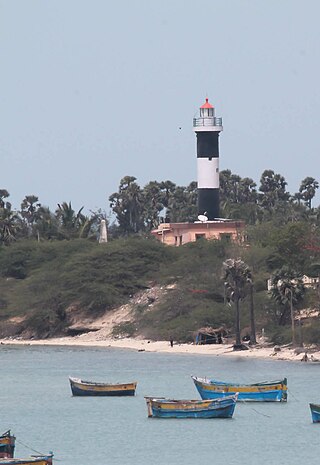
The Pamban Lighthouse is one of the two lighthouses on the Rameswaram island in Tamil Nadu. It is also known as Pamban channel northwest point lighthouse.
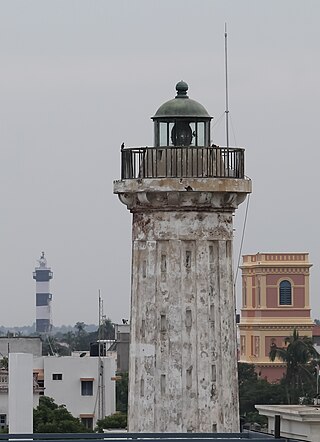
A lighthouse was constructed in Pondicherry in the nineteenth century by the French rulers. A new lighthouse was constructed in 20th century by the government of India. The old lighthouse had first beamed light on 1 September 1836. The new lighthouse started functioning in 1979.

Manakkodam Lighthouse is situated next to the Andhakaranazhy beach in the Alappuzha district of Kerala near Cherthala. The tower is a 33.8 metres (110.9 ft) high concrete structure with square cross section. It was inaugurated on 1 August 1979. There were no lights in this area before 1979. The light source was changed from incandescent lamp to metal halide on 21 September 1998.

Kilakkarai Lighthouse is located at Kilakkarai, Tamil Nadu. The lighthouse started functioning on 2 October 1979. There was no lighthouse at this location prior to the installation of the present structure. A flag mast was present at this location previously to assist fishermen. The light source was modified on 30 April 2003.

Tangasseri Lighthouse or Thangassery Lighthouse is situated at Tangasseri in Kollam city of the Indian state of Kerala. It is one of the two lighthouses in the Kollam Metropolitan Area and is maintained by the Cochin Directorate General of Lighthouses and Lightships. In operation since 1902, the cylindrical lighthouse tower painted with white and red oblique bands has a height of 41 metres (135 ft), making it the second tallest lighthouse in Kerala coast. Tangasseri Lighthouse is one of the most visited lighthouses in Kerala.

Ponnani Lighthouse is situated in Ponnani, Malappuram district, Kerala on the south bank of the Bharathappuzha river. It was commissioned on 17 April 1983. The tower has a circular cross-section and a height of 30 meters. The light source is a metal halide lamp. The lighthouse has direct drive facility. The Ponnani port is located on the estuary of River Bharathappuzha and Tirur River.

The Chetwai Lighthouse is situated at Chettuva near Guruvayur in Thrissur District of Kerala. It was inaugurated on 29 September 1986. The tower is a 30-meter tall concrete structure. There did not exist any lighthouse earlier to the present one at this place. The light source was changed on 30 April 2003.
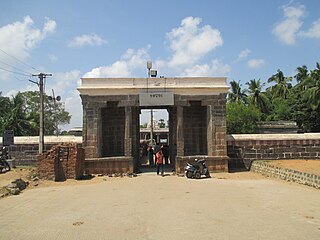
Nithyakalayana Perumal temple in Thiruvidandai, a village in Chennai, Chengalpattu district of the South Indian state of Tamil Nadu, is dedicated to Varaha, the boar avatar of the Hindu god Vishnu. Constructed in the Tamil style of architecture, the temple is glorified in the Naalayira Divya Prabandham, the early medieval Tamil canon of the Alvar saints from the 6th–9th centuries CE. It is one of the 108 Divya Desams dedicated to Vishnu, who is worshipped as Nithyakalayana Perumal (Varaha) and his consort Lakshmi as Komalavalli Thayar. The original structure of the temple was built by the Pallavas during the 7th century CE, with later additions from the Cholas during the 11th century.

Krishna's Butterball is a gigantic balancing rock, granite-boulder resting on a short incline in the historical coastal resort town of Mamallapuram in Tamil Nadu state of India.
Kuthur Ramakrishnan Srinivasan was an Indian archeologist, historian and the author of a number of books on Indian history and culture. He was best known for his archeological work on the Cave Temples of Mahabalipuram. The Government of India awarded him the Padma Bhushan, the third highest civilian award, in 1991.





















